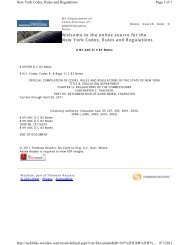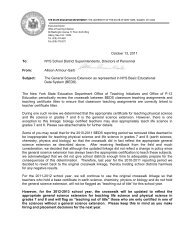ESL Learning Standards - Higher Ed - New York State Education ...
ESL Learning Standards - Higher Ed - New York State Education ...
ESL Learning Standards - Higher Ed - New York State Education ...
You also want an ePaper? Increase the reach of your titles
YUMPU automatically turns print PDFs into web optimized ePapers that Google loves.
Students will demonstrate cross-cultural knowledge and sensitivity in communicating with others of<br />
varied social, cultural, and linguistic backgrounds. They will develop and use culturally appropriate<br />
behaviors, and a knowledge of local and U.S. cultures and practices, in their interactions with<br />
others in their new cultural environment.<br />
Performance Indicators: See page 28<br />
Advanced<br />
Students complete Intermediate task. Students interview<br />
parents about ways the parents overcame some childhood<br />
fears listed on the class chart. Students present their findings<br />
to the class and, as a whole class, students compare<br />
and contrast fears and solutions from different cultures.<br />
Students share selected words, phrases, or utterances from<br />
their native language that describe or express fear.<br />
Performance indicators: 1, 3, 6<br />
English Proficiency Level<br />
Transitional<br />
Students complete Advanced task. With teacher assistance,<br />
class compiles three or four fears from class chart and various<br />
cultural approaches to eliminating or diminishing these<br />
fears into a booklet for class library.<br />
Performance indicators: 1, 3, 6<br />
After listening to and/or reading folktales from different<br />
cultures (e.g., Why the Sun and the Moon Live in the Sky<br />
[Africa] and Why Opossum Is Gray [Mexico]), students discuss<br />
themes of each story and share personal experiences<br />
of solving a problem in their lives by making a change.<br />
Teacher compiles these experiences, using the learning<br />
experience approach, into a class story.<br />
Performance indicators: 5<br />
Students complete Intermediate task. In pairs, students<br />
develop an illustrated book entitled “These Are the Ways of<br />
Going to School,” which depicts parents’ and students’<br />
methods of getting to school.<br />
Performance indicators: 1, 3, 6<br />
Students complete Advanced task. Teacher writes out story<br />
that class creates on the basis of the theme, using invented<br />
characters and setting. Pairs of students write out and illustrate<br />
different pieces of the story, which is compiled into a<br />
storybook.<br />
Performance indicators: 5<br />
Students complete Advanced task. Students add to the<br />
book with illustrations and descriptions by predicting and<br />
fantasizing about future methods of traveling to school.<br />
Performance indicators: 1, 3, 6<br />
<strong>ESL</strong><br />
5<br />
Pre-K<br />
– 1<br />
Students complete Intermediate task. They list types of<br />
costumes they have seen worn for Halloween. They bring<br />
in pictures, photos, or illustrations of costumes worn in<br />
their native country for a particular holiday. Class compares<br />
costumes from different countries to those worn for<br />
Halloween in the United <strong>State</strong>s, and posts costumes side by<br />
side on holiday bulletin board.<br />
Performance indicators: 2, 3, 5<br />
Students complete Advanced task. With teacher assistance,<br />
students write short descriptions of costumes and characters<br />
described in Advanced task, and include these descriptions<br />
with the illustrations on the holiday bulletin board.<br />
Performance indicators: 2, 3, 5<br />
CLASSROOM<br />
TASKS<br />
Sample Classroom Tasks 41
















